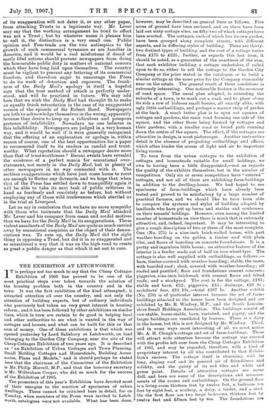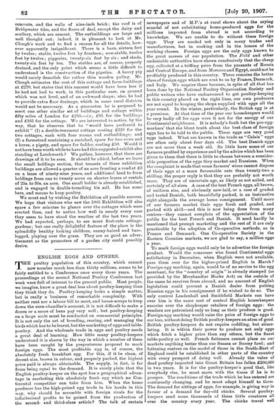THE EXHIBITION AT LETCHWORTH.
T is perhaps not too much to say that the Cheap Cottages 1 Exhibition of 1905 has proved to be one of the most practical steps ever taken towards the solution of the housing problem both in the country and in the town. It was the first exhibition of the kind attempted ; it attracted attention all over the country, and not only the attention of building experts, but of ordinary individuals who previously had taken no very great interest in housing reform ; and it has been followed by other exhibitions on similar lines, which in turn are certain to do good in helping local and other authorities to see what is wanted in the way of cottages and houses, and what can be built for this or that sum of money. One of these exhibitions is that which was opened yesterday by Lord Salisbury at Letchworth, on land belonging to the Garden City Company, near the site of the Cheap Cottages Exhibition of two years ago. It is described as "an Exhibition of Urbgn Cottages and Town Planning, Small Holding Cottages aad Homesteads, Building Acces- sories, Plans and Models," and it should perhaps be stated here that the chairman of the Committee of the Exhibition is Mr. Philip Morrell, M.P., and that the honorary secretary is Mr. Wilbraham Cooper, who did so much for the success of the Exhibition of 1905.
The promoters of this year's Exhibition have devoted most of their energies to the erection of specimens of urban dwellings. These cannot be criticised here in detail, for on Tuesday, when members of the Press were invited to Letch- worth, catalogues were-not available. What has been done, however, may be described on general lines as follows. Five acres of ground have been enclosed, and on these have been laid out sixty cottage sites, on fifty-two of which cottages have been erected. The cottages, each of which has its own garden, have been grouped along complete streets, with different aspects, and in differing styles of building.. There are thirty- two distinct types of building, and the cost of a cottage varies from 2175 to £225; further, as regards this last item, it should be noted, as a guarantee of the exactness of the sum, that each exhibitor building a cottage undertakes, if called upon to do so, either to sell the cottage to the Garden City Company at the price stated in the catalogue, or to build a similar cottage at the same price for the Company reasonably near on the estate. The general result of these conditions is extremely interesting. One noticeable feature is the economy of road space. The usual plan adopted, in extending the suburbs of a town, is to mark out a road, and to place along its side a row of hideous small houses, all exactly alike, with ugly little outbuildings, and perhaps a narrow strip of garden at the back. A much better plan is to open out squares of cottages and gardens, the main road forming one side of the square, and the other three being formed by cottages and their gardens, with a smaller road or broad path running down the centre of the square. The effect, if the cottages are attractive in design, is most picturesque. Another instructive detail is the absence of projecting outbuildings and offices, which often hinder the access of light and air to important living-rooms.
To turn from the urban cottages to the exhibition of cottages and homesteads suitable for small holdings, we own to having been a little disappointed,—not as regards the quality of the exhibits themselves, but in the number of competitors. Only six or seven competitors have " entered " cottages, and not all of these are exhibiting farm-buildings in addition to the dwelling-house. We had hoped to see specimens of farm-buildings which have already been tested and proved to be satisfactory by a large number of practical farmers, and we should like to have been able to compare the systems and styles of building adopted by landlords who have put up barns and stables and cowhouses on their tenants' holdings. However, even among the limited number of homesteads on view there is much that is extremely attractive, and, indeed, important. It may be interesting to give a rough description of two or three of the most complete. One (No. 275) is a nine-inch brick-walled house, with part weather-boarding on the gables, a timber roof with plain tiles, and floors of boarding on concrete foundations. It is a pretty and ingenious little house ; an attractive feature of the interior is a fender made out of half an iron wheel-tyre. The cottage is also well supplied with outbuildings, as follows :— barn, timber-covered with weather-boarding; stable, the same, with boarded roof ; shed, covered with weather-boarding ; all roofed and pantiled; floor and foundations cement concrete; piggeries, nine-inch brickwork with cement floors and felted roofs ; and a stockyard. The cost is for the cottage, £183; stable and barn, 252; piggeries, £15; drainage, 223 8s. ; architects' fees, 213 13s.,—total 2287 is. Another exhibit (No. 270) is of particular interest because the set of farm- buildings attached to the house have been designed and are exhibited by Mr. R. Winfrey, M.P., and the South Lincoln- shire Small Holdings Association. The buildings consist of cow-stable, horse-stable, barn, cartshed, and pigsty, and the larger buildings are ventilated by louvres. There is a dairy in the house, but this is not designed by Mr. Winfrey. Third, and in some ways most interesting of all, we must notice Mr. A. H. Clough's cottage and set of farm-buildings. These will attract wide attention because the cottage was erected with the profits left over from the Cheap Cottages Exhibition of 1905, and may be regarded, therefore, with a kind of proprietary interest by all who contributed to that Exhibi- tion's success. The cottage itself is charming, with its long, sloping roof and its general air of friendliness and solidity, and the gaiety of its red tiles and white and green paint. Details of attractive cottages are never dull, and here are some of the descriptions and measure- ments of the rooms and outbuildings. On the ground floor is a living-room thirteen feet by twelve feet, a bedroom ten feet by eight feet, a scullery, a dairy, a larder, and a shed. On the first floor are two large bedrooms, thirteen feet by twelve feet and fifteen feet by ten. The foundations are
eoncrete, and the walls of nine-inch brick ; the roof is of Bridgwater tiles, and the floors of deal, except the dairy and scullery, which are cement. The outbuildings are large and well thought out; indeed, it is pleasant to look at Mr. Clough's work and to find a reason for all the details, how- ever apparently insignificant. There is a barn, sixteen feet by twelve ; stable, twelve feet by fourteen ; cow-stable, twelve feet by twelve ; piggeries, twenty-six feet by six ; and sheds, twenty-six feet by ten. The stables are, of course, properly drained, and the only point which seems a little difficult to understand is the construction of the pigsties. A heavy pig would surely demolish the rather thin wooden paling. Mr. Clough estimates the cost of this cottage and farm-buildings at 2270, but states that this amount would have been less if he had not had to work, in this particular case, on ground which was not level, and of an awkward (shape; also, he had to provide extra floor drainage, which in some rural districts would not be necessary. As a guarantee, he is prepared to erect one other similar set of buildings and cottage within fifty miles of London for £250,—i.e., £85 for the buildings and 2165 for the cottage. We are interested to notice, by the way, that he observes that he "would have preferred to exhibit" (1) a double-tenement cottage costing 2220 for the two cottages, each with four rooms and outbuildings; and (2) a farmstead containing a cartshed, space for two cows and a horse, a pigsty, and space for fodder, costing 250. Would it not have been worth while to have had this suggested exhibit also standing at Letchworth ? We gather, however, that there are drawings of it to be seen. It should be added, before we leave the small holdings section, that tenants of these exhibition buildings are allowed a quarter of an acre fronting a road at 23 on a lease of ninety-nine years, and additional land to form holdings from one to twenty acres on shorter leases at rentals of 25s. to Ns. an acre. One small holder is already established, and is engaged in double-trenching his soil. He has some bees, and means to keep poultry.
We must end by wishing the Exhibition all possible success. We hope that visitors who saw the 1905 Exhibition will also spare a few minutes to glance over the cottages which were erected then, and to notice how well in nearly every case they seem to have stood the weather of the last two years. We had expected, perhaps, to see more first-rate cottage- gardens ; but one really delightful feature of the place is the splendidly healthy looking children, sunny-haired and bare- legged, playing over the grass. They are as good an adver- tisement as the promoters of a garden city could possibly desire.







































 Previous page
Previous page